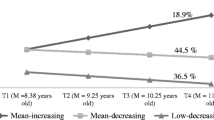Abstract
Interparental aggression has long been implicated as a cause of child and adolescent antisocial behavior. Four theoretical explanations (viz., an aggressogenic cognition model, general strain theory, an emotional security model, and a spillover model) have been proposed to account for this deleterious effect. To gain a better understanding of the mechanism whereby interparental aggression promotes antisocial behavior, this study tests the competing explanations simultaneously using longitudinal data from a sample of 508 African American families with a child aged 12–14 (53.5% are girls). Using path analysis, the results support both the general strain theory and the emotional security model for girls. The results also show weak support for the spillover model. Whereas, for boys, all of the four explanations were supported, though the support for the spillover model is weak. Thus, the findings suggest that the mechanisms whereby interparental aggression fosters antisocial behavior may differ by gender. Implications and limitations of the current research are discussed.


Similar content being viewed by others
References
Agnew, R. (1992). Foundation for a general strain theory of crime and delinquency. Criminology, 30(1), 47–87.
Agnew, R. (2001). Pressured into crime: An overview of general strain theory. Los Angeles, California: Roxbury Publishing Company.
American Psychiatric Association. (1994). Diagnostic and statistical manual of mental disorders. Washington, DC: American Psychiatric Association.
Anderson, D. A. (1999). The aggregated burden of crime. Journal of Law and Economics (42), 611–642.
Arbuckle, J. L., & Wothke, W. (1999). AMOS 4.0 users guide. Chicago: Small Waters Corporation.
Blumstein, A., & Wallman, J. (2000). The crime drop in America. Cambridge, New York: Cambridge University Press.
Broidy, L., & Agnew, R. (1997). Gender and crime: A general strain theory perspective. Journal of Research in Crime and Delinquency, 34(3), 275–306.
Bumpass, L., & Lu, H. H. (2000). Trends in cohabitation and implications for children’s family contexts in the United States. Population Studies-a Journal of Demography, 54(1), 29–41.
Caspi, A., & Moffitt, T. E. (1995). The continuity of maladaptive behavior: From description to understanding in the study of antisocial behavior. In D. Cicchetti & D. J. Cohen (Eds.), Manual of developmental psycholopathology (Vol. 2, pp. 472–511). New York: Wiley.
Conger, R. D., Conger, K. J., Elder, G. H., Lorenz, F. O., Simons, R. L., & Whitbeck, L. B. (1992a). A family process model of economic hardship and adjustment of early adolescent boys. Child Development, 63(3), 526–541.
Conger, R. D., Conger, K. J., Lorenz, F. O., Simons, R. L., & Whitbeck, L. B. (1992b). A family process model of economic hardship and influences on adjustment of early adolescent boys. Child Development, 63, 526–541.
Conger, R. D., Ge, X., Elder, G. H., Lorenz, F. O., & Simons, R. L. (1994). Economic-stress, coercive family process, and developmental problems of adolescents. Child Development, 65(2), 541–561.
Conger, R. D., Wallace, L. E., Sun, Y. M., Simons, R. L., McLoyd, V. C., & Brody, G. H. (2002). Economic pressure in African American families: A replication and extension of the family stress model. Developmental Psychology, 38(2), 179–193.
Cui, M., Lorenz, F. O., Conger, R. D., Melby, J. N., & Bryant, C. M. (2005). Observer, self-, and partner reports of hostile behaviors in romantic relationships. Journal of Marriage and the Family, 67(5), 1169–1181.
Cummings, E. M., Goeke-Morey, M. C., & Papp, L. M. (2003). Children’s responses to everyday marital conflict tactics in the home. Child Development, 74(6), 1918–1929.
Cummings, E. M., Schermerhorn, A. C., Davies, P. T., Goeke-Morey, M. C., & Cummings, J. S. (2006). Interparental discord and child adjustment: Prospective investigations of emotional security as an explanatory mechanism. Child Development, 77(1), 132–152.
Davies, P. T., & Cummings, E. M. (1994). Marital conflict and child adjustment—an emotional security hypothesis. Psychological Bulletin, 116(3), 387–411.
Davies, P. T., & Cummings, E. M. (2006). Interparental disord, family process, and developmental psychology. In D. Cicchetti & D. J. Cohen (Eds.), Developmental psychopathology (Vol. 3, pp. 86–128). London: Wiley.
Davies, P. T., Cummings, E. M., & Winter, M. A. (2004). Pathways between profiles of family functioning, child security in the interparental subsystem, and child psychological problems. Development and Psychopathology, 16(3), 525–550.
Davies, P. T., Harold, G. T., Geoke-Morey, M. C., & Cummings, E. M. (2002). Child emotional security and interparental conflict. Boston, Mass: Blackwell Publishing.
Davies, P. T., Sturge-Apple, M. L., Woitach, M. J., & Cummings, E. M. (2009). A process analysis of the transmission of distress from interparental conflict to parenting: adult relationship security as an explanatory mechanism. Developmental Psychology, 45(6), 1761–1773.
Dodge, K. A. (1986). A social information processing model of social competence in children. In M. Perlmutter (Ed.), Minnesota symposium on child psychology (Vol. 18, pp. 77–125). Hillsdale, NJ: Erlbaum.
Dodge, K. A., Coie, J. D., & Lynam, D. (2006). Aggression and antisocial behavior in youth. In N. Eisenberg, W. Damon, & R. Lerner (Eds.), Handbook of child psychology (Vol. 3, pp. 719–788). Hoboken, NJ: Wiley.
Dodge, K. A., Price, J. M., Bachorowski, J.-A., & Newman, J. P. (1990). Hostile attributional biases in severely aggressive adolescents. Journal of Abnormal Psychology, 99(4), 385–392.
Ei-Sheikh, M., Cummings, E. M., Kouros, C. D., Elmore-Staton, L., & Buckhalt, J. (2008). Marital psychological and physical aggression and children’s mental and physical health: direct, mediated, and moderated effects. Journal of Consulting and Clinical Psychology, 76(1), 138–148.
Fincham, F. D., Grych, J. H., & Osborne, L. N. (1994). Does marital conflict cause child maladjustment? Directions and challenges for longitudinal research. Journal of Family Psychology, 8(2), 128–140.
Fite, J. E., Bates, J. E., Holtzworth-Munroe, A., Dodge, K. A., Nay, S. Y., & Pettit, G. S. (2008). Social information processing mediates the intergenerational transmission of aggressiveness in romantic relationships. Journal of Family Psychology, 22(3), 367–376.
George, D., & Mallery, P. (2003). SPSS for windows step by step: A simple guide and reference 11.0 update (4th ed.). Boston: Allyn & Bacon.
Gerard, J. M., Krishnakumar, A., & Buehler, C. (2006). Marital conflict, parent-child relations, and youth maladjustment—a longitudinal investigation of spillover effects. Journal of Family Issues, 27(7), 951–975.
Gottfredson, M. R., & Hirschi, T. (1990). A general theory of crime. Stanford, CA: Stanford University Press.
Grych, J. H., & Fincham, F. D. (1990). Marital conflict and children’s adjustment—a cognitive-contextual framework. Psychological Bulletin, 108(2), 267–290.
Grych, J. H., Wachsmuth-Schlaefer, T., & Klockow, L. L. (2002). Interparental aggression and young children’s representations of family relationships. Journal of Family Psychology, 16(3), 259–272.
Hay, C. (2003). Family strain, gender, and delinquency. Sociological Perspectives, 46(1), 107–135.
Hsueh, A. C., Morrison, K. R., & Doss, B. D. (2009). Qualitative reports of problems in cohabiting relationships: Comparisons to married and dating relationships. Journal of Family Psychology, 23(2), 236–246.
Hummer, R. A., & Hamilton, E. R. (2010). Race and ethnicity in fragile families. Future of Children, 20(2), 113–131.
Jaccard, J., & Wan, C. K. (1996). LISREL approaches to interaction effects in multiple regression. Thousand Oaks: International Professional and Educational Publisher.
Jenkins, J. M. (2000). Marital conflict and children’s emotions: The development of an anger organization. Journal of Marriage and the Family, 62(3), 723–736.
Jeoreskog, K. G., & Seorbom, D. (1993). LISEREL 8 user’s reference guide. Chicago, ILL: Scientific Software International.
Kalenkoski, C. M., Ribar, D. C., & Stratton, L. S. (2005). Parental child care in single-parent, cohabiting, and married-couple families: Time-diary evidence from the United Kingdom. American Economic Review, 95(2), 194–198.
Kelloway, K. E. (1998). Using LISREL for structural equation modeling: A researcher’s guide. Thousand Oaks, CA: Sage Publications.
Kendig, S. M., & Bianchi, S. M. (2008). Single, cohabitating, and married mothers’ time with children. Journal of Marriage and the Family, 70(5), 1228–1240.
Kinsfogel, K. M., & Grych, J. H. (2004). Interparental conflict and adolescent dating relationships: Integrating cognitive, emotional, and peer influences. Journal of Family Psychology, 18(3), 505–515.
Krishnakumar, A., Buehler, C., & Barber, B. K. (2003). Youth perceptions of interparental conflict, ineffective parenting, and youth problem behaviors in European-American and African-American families. Journal of Social and Personal Relationships, 20(2), 239–260.
Marcus, N. E., Lindahl, K. M., & Malik, N. M. (2001). Interparental conflict, children’s social cognitions, and child aggression: A test of a mediational model. Journal of Family Psychology, 15(2), 315–333.
Maxwell, S. R. (2001). A focus on familial strain: antisocial behavior and delinquency in Filipino society. Sociological Inquiry, 71(3), 265–292.
Moon, B., Blurton, D., & McCluskey, J. D. (2008). General strain theory and delinquency—focusing on the influences of key strain characteristics on delinquency. Crime & Delinquency, 54(4), 582–613.
Muthen, L. K., & Muthen, B. O. (2004). Mplus: The comprehensive modeling program for applied researchers. User’s guide (3rd ed.). Los Angeles: Muthen & Muthen.
Onyskiw, J. E., & Hayduk, L. A. (2001). Processes underlying children’s adjustment in families characterized by physical aggression. Family Relations, 50(4), 376–385.
Pearson, J. L., Hunter, A. G., Ensminger, M. E., & Kellam, S. G. (1990). Black grandmothers in multigenerational households—diversity in family structure and parenting involvement in the woodlawn community. Child Development, 61(2), 434–442.
Schmitt, N. (1996). Use and abuse of coefficient alpha. Psychological Assessment, 8(4), 350–353.
Shaffer, D., Schwab-stone, M., Fisher, P., Cohen, P., Piacentini, J., Davies, M., et al. (1993). The Diagnostic Interview Schedule for Children revised version (DISC-R).1. Preparation, field testing, interrater reliability, and acceptability. Journal of the American Academy of Child and Adolescent Psychiatry, 32(3), 643–650.
Sigfusdottir, I.-D., Farkas, G., & Silver, E. (2004). The role of depressed mood and anger in the relationship between family conflict and delinquent behavior. Journal of Youth and Adolescence, 33(6), 509–522.
Simons, R. L., & Associates. (1996). Understanding differences between divorced and intact families. Thousand Oaks, California: Sage Publications.
Simons, R. L., Chao, W., Conger, R. D., & Elder, G. H. (2001). Quality of parenting as mediator of the effect of childhood defiance on adolescent friendship choices and delinquency: A growth curve analysis. Journal of Marriage and the Family, 63(1), 63–79.
Simons, R. L., Murry, V., McLoyd, V., Lin, K.-H., Cutrona, C., & Conger, R. D. (2002). Discrimination, crime, ethnic identity, and parenting as correlates of depressive symptoms among African American children: A multilevel analysis. Development and Psychopathology, 14(2), 371–393.
Simons, R. L., Simons, L. G., Burt, C. H., Drummund, H., Stewart, E., Brody, G. H., et al. (2006). Supportive parenting moderates the effect of discrimination upon anger, hostile view of relationships, and violence among African American boys. Journal of Health and Social Behavior, 47(4), 373–389.
Simons, R. L., Simons, L. G., & Wallace, L. E. (2005). Families, delinquency, and crime: Linking society’s most basic institution to antisocial behavior. New York, NY: Oxford University Press.
Simons, R. L., Whitbeck, L. B., Conger, R. D., & Wu, C. I. (1991). Intergenerational transmission of harsh parenting. Developmental Psychology, 27(1), 159–171.
Sturge-Apple, M. L., Davies, P. T., & Cummings, E. M. (2006). Impact of hostility and withdrawal in interparental conflict on parental emotional unavailability and children’s adjustment difficulties. Child Development, 77(6), 1623–1641.
Synder, H. N. (2003). Juvenile arrests 2001. Washington, DC: US Department of Justice. Office of Justice Programs. Office of Juvenile Justice and Delinquency Prevention.
Thornberry, T. P. (1987). Toward an interactional theory of delinquency. Criminology, 25(4), 863–891.
Zimet, D. M., & Jacob, T. (2001). Influences of marital conflict on child adjustment: Review of theory and research. Clinical Child and Family Psychology Review, 4(4), 319–335.
Acknowledgments
This research was supported by the National Institute of Mental Health (MH48165, MH62669) and the Center for Disease Control (029136-02). Additional funding for this project was provided by the National Institute on Drug Abuse and the National Institute on Alcohol Abuse and Alcoholism. An earlier version of this paper was presented in the 2010 annual meeting of American Sociological Association in Atlanta, GA.
Author information
Authors and Affiliations
Corresponding author
Rights and permissions
About this article
Cite this article
Su, X., Simons, R.L. & Simons, L.G. Interparental Aggression and Antisocial Behavior Among African American Youth: A Simultaneous Test of Competing Explanations. J Youth Adolescence 40, 1489–1502 (2011). https://doi.org/10.1007/s10964-011-9673-3
Received:
Accepted:
Published:
Issue Date:
DOI: https://doi.org/10.1007/s10964-011-9673-3




